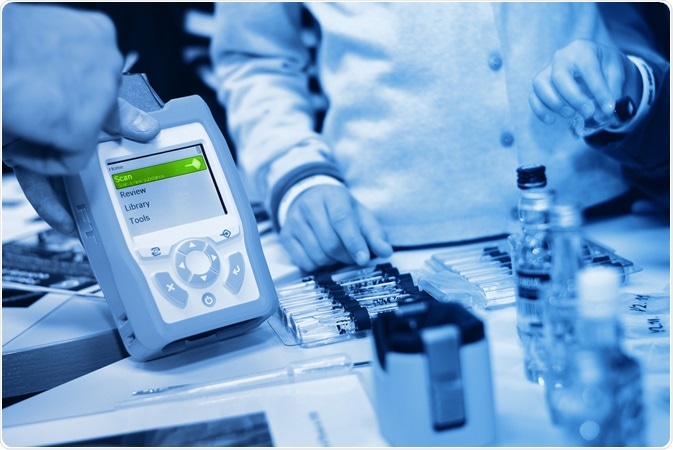Molecular spectroscopy is a complex scientific method that uses the interaction of electromagnetic radiation with matter to provide precise details on the makeup and arrangement of molecules. Over the years, this method has had considerable breakthroughs in both technological progress and its wide use across numerous industries.
Considered a fundamental tool in both academic and industry research, molecular spectroscopy allows researchers to deduce molecular identities, structures, and surroundings by analyzing how molecules absorb, emit, or scatter light. To help you understand its complexities, this article will explore the intricacies of molecular spectroscopy, as well as its benefits and applications.
Instruments of Molecular Spectroscopy
Molecular spectroscopy instruments are tailored to specific types of analysis and spectral range. Here are some of the key analytical instruments:
1. UV-Visible Spectroscopy
This method examines the electronic states of molecules by using both ultraviolet and visible light. It is essential in disciplines like biochemistry and environmental science and is frequently used in quantitative analysis to assist in determining the concentration of chemicals.
2. Infrared (IR) Spectroscopy
IR spectroscopy is essential for determining functional groups and understanding chemical structures since it analyzes the vibration of molecules. Its variations, such as Fourier-transform infrared (FTIR) spectroscopy, improve analysis speed and resolution, which is why organic chemistry and materials science use it so extensively.
3. Nuclear Magnetic Resonance (NMR) Spectroscopy
Using nuclear magnetic resonance (NMR) spectroscopy, you can obtain comprehensive knowledge of the kinetics, structure, status of a reaction, and chemical environment of molecules. In organic chemistry, it is particularly helpful in clarifying the identification and structure of molecules.
4. Mass spectrometry (MS)
Although it is often regarded as a distinct field, MS can be used in conjunction with spectroscopic methods to improve the depth of molecular analysis by analyzing the mass and formula of molecules from complicated mixtures.
5. Raman Spectroscopy
The basis of Raman Spectroscopy is the inelastic scattering of light, often known as Raman scattering. It is non-destructive, enabling analysis without causing damage to the sample, and it is very specific for vibrational and rotational transitions.
Benefits of Molecular Spectroscopy
Here are the main benefits of using molecular spectroscopy in a wide range of sciences:
- Sensitivity and Precision: molecule spectroscopy provides extremely sensitive and precise measurements that can identify even the smallest alterations in molecule structures.
- Non-Destructive Analysis: Non-destructive methods of analyzing samples are provided by methods such as FTIR spectroscopy and Raman spectroscopy, which help to protect priceless samples.
- Versatility: Molecular spectroscopy is useful in a wide range of domains, including forensics, environmental research, and pharmacology, as it can analyze nearly any sort of sample, including gasses, liquids, and solids.
- Speed and Efficiency: A great deal of spectroscopic analysis may be completed rapidly, yielding data that is nearly instantaneous and essential for situations involving process control and quality assurance.
Applications of Molecular Spectroscopy
So, which fields are benefiting from the benefits of molecular spectroscopy? Here are some key industries:
Chemical and Pharmaceutical Industries
In the pharmaceutical industry, molecular spectroscopy plays a crucial role in medication development and discovery. It is employed to characterize raw materials, track synthesis, and guarantee final product quality.
Environmental Monitoring
The study of atmospheric chemistry and the monitoring of environmental pollutants depend heavily on methods like UV-visible and IR spectroscopy. They support monitoring changes in the quality of the air and water as well as comprehension of the effects of different pollutants.
Food and Beverage Testing
Spectroscopy can verify ingredient purity and identify adulteration. Raman spectroscopy, for example, is used to verify the provenance of food items such as wine and olive oil.
Medical Diagnostics
By examining tissue samples and bodily fluids, infrared and Raman spectroscopy are being employed more and more in medical diagnostics, including the early diagnosis of diseases.
Material Science
Spectroscopic techniques play a major role in the investigation of materials, including metals, polymers, and ceramics, to understand the behavior and properties of materials under various conditions.
The Future of Molecular Spectroscopy
Technological developments and the incorporation of digital technology will play a significant role in the future of molecular spectroscopy. The combination of spectroscopic data with machine learning algorithms is improving this technique’s prediction power, resulting in quicker and more precise evaluations.
Molecular spectroscopy is a cutting-edge scientific field. Its tools offer the prisms through which the world of molecules is viewed and comprehended, and its advantages guarantee its broad application in a multitude of scientific and industrial fields. This field’s ongoing development is expected to yield an even more profound understanding of the molecular foundations of the environment we live in.






